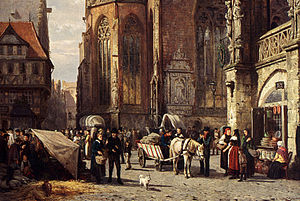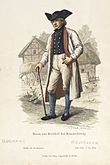Braunschweig costume

|

|
|
|
Braunschweig traditional costumes in a street scene in the city of Braunschweig, painting detail by Jacques Carabain , 19th century.
|
Scene on the old town market in Braunschweig, detail from a painting by Cornelis Springer , 19th century.
|
The Braunschweiger Tracht is a traditional clothing from the former Duchy of Braunschweig or the Braunschweiger Land from around 1840. It was probably worn in the entire area of the Duchy and in variants in the adjacent areas.
The costume of women
The women's costume is brightly colored. It consists of an approximately calf-length red skirt , which is covered with a green stripe at the bottom. It is laid in tight folds at the back and sides, but the front part covered by the apron remains smooth.


lithograph by Bernhard Plockhorst , 19th century
A short white blouse (neck shirt) is worn for this. It has half-length sleeves and a wide collar (frese) that falls in loose ruffles or folds over the shoulders.
A wide cut black bodice ( doublet ) comes over this , it reaches to the waist and is closed at the front with small buttons. A loop made of embroidered silk ribbon is fastened under the frieze and loosely hangs down at the front.
An embroidered white cloth made of cotton - laid in a triangle - covers the upper part of the back, as well as shoulders and chest, the tips disappear in the front of the bodice. The embroidery pattern is repeated on the apron, which is also white.
A small cap made of black silk fabric is part of the headgear, which is also decorated with elaborate embroidery and long hanging ribbons.
The stockings are white, with wide-cut black leather shoes with a small heel. They are also adorned with a silver buckle on the front .
The costume of men
The men especially noticed the white coat ( smock ) with light red lining, which was also used in other areas of Lower Saxony . It reaches half of the lower leg in length, has red piped pocket flaps and about two-thirds of the front with a row of brass buttons.
A special form of the vest (Bostdauk) is worn underneath. It is made of red wool and has an armhole on the right, but it is closed with buttons on the left. The neck hole and the short clasp in the front center are edged with green trimmings.
A black scarf made of cotton or silk is worn in the neckline of the white linen shirt . Knickerbockers (Büxen) of light leather, blue stockings (sülmst geknüttet) and black shoes with wide silver buckles complete the costume.
A wide-brimmed black felt hat ( tricorn or three-pimple hat) is worn as headgear . Its brim is turned up and fastened on three sides, one side is decorated with a button and hanging ribbons.
Accounts from contemporary witnesses
Contemporary witnesses, such as the French writer Stendhal (1783–1842) and the German writer and politician Heinrich Laube (1806–1884), also report on the different colors of the Braunschweig costume:
“In addition, every man wears high boots, lots of black necklaces, huge three-pointed tips, and the clothes have a strict cut. Never something light, nothing that tends to be pretentious or ridiculous. "
“A broad, black hat shadows the dark, strict face. […] Everyone wears a black scarf, a deep dark skirt lined with a red frieze and studded from top to bottom with massive lead buttons. A canvas smock is only pulled over the black underwear in hot summer. "
literature
- Richard Andree : Braunschweiger Volkskunde Braunschweig 1901
Web links
Individual evidence
- ↑ Stendhal: Impressions from Northern Germany . In: Confessions of an Ichmenschen , Propylaea, Berlin 1923
- ^ Heinrich Laube: Travel novels . Volume 1, Otto Wigand, Leipzig 1834

